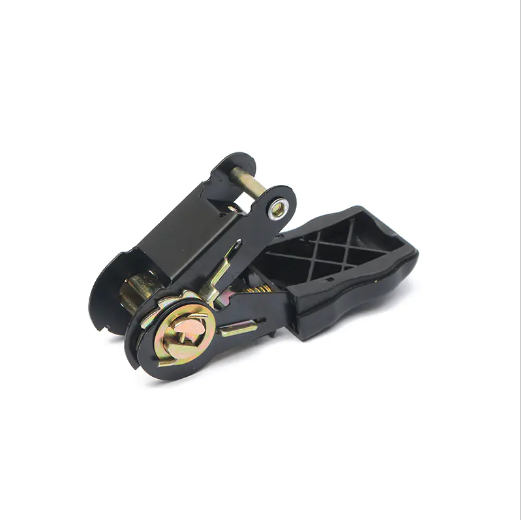No.2 new District Minglun Village,Wuxiang Town,Yinzhou District
-

Tel: +86 18658447778
-

E-mail: [email protected]
-


As the core component of cargo straps (such as ratchet straps and tensioners), metal ratchet buckles achieve efficient and safe cargo fixation through mechanical locking and tension adjustment, and are widely used in logistics, transportation and industrial fields.
1. Core functions and working principles
(1) Mechanical locking and one-way tightening
The metal ratchet buckle adopts a ratchet and pawl structure inside. The handle is rotated to drive the gear to rotate in one direction, gradually tightening the webbing, and the pawl is used to clamp the gear to prevent rebound, forming a "step-by-step tightening" locking effect.
The typical load-bearing range covers 500kg to 5000kg (such as RS PRO brand products). The high-strength metal material ensures stable tension in bumpy environments.
(2) Precise tension control
The user can fine-tune the tightness of the webbing by rotating the handle to avoid deformation of the cargo or breakage of the webbing due to excessive tension. For example, when fixing fragile glass, a ratchet buckle with corresponding tension should be selected according to the weight of the cargo.
2. Typical application scenarios
(1) Logistics and transportation fixation
Truck/container cargo: Bundle heavy objects such as steel, mechanical equipment, and containers to prevent displacement caused by braking or bumps. For example, in semi-trailer transportation, the "blocking method" is used to fix the ratchet tensioner hooks on both sides of the car body to form a lateral constraint.
Special cargo adaptation:
Fragile items (such as glass and tiles): Use webbing to fully wrap the cargo and combine it with metal fasteners to fix it at multiple points to disperse the pressure.
Irregular items (such as steel cages): Use "cabling rope" vertical bundling to enhance stability through triangular structure.
(2) Outdoor and industrial scenes
Tent/canvas fixation: Adjust the tension of the waterproof cloth to resist strong winds.
Equipment lifting and storage: Fix the generator and lawn mower on the trailer, or bundle the pipes and wood in the warehouse.
Temporary repair and DIY projects: Act as a temporary cable to repair fences and furniture, or fix the workpieces under construction.
(3) Special operations
Ship and high-altitude operations: Adjusting the tension of sailing ropes and reinforcing mountaineering equipment rely on the corrosion resistance of ratchet buckles (such as 316 stainless steel).
Petroleum/communication engineering: Use stainless steel cable ties to fix cables or pipes, adapting to harsh outdoor environments.
3. Technical advantages and design innovations
(1) Labor-saving and efficient
The ratchet mechanism uses the principle of "four ounces to move a thousand pounds" to amplify the operating force. A single person can complete the tightening of several tons of cargo, and the efficiency is more than 70% higher than that of traditional knots.
(2) Enhanced safety
Anti-slip design: The metal buckle and the webbing interface are riveted or sewn to prevent unhooking; some models have an anti-rust coating (such as galvanized treatment) to extend the service life in humid environments.
Edge protection: Sharp goods need to be equipped with corner guards to prevent the webbing from being cut.
(3) Modularity and customization
Snap-on ratchet tensioner: supports quick disassembly and assembly, suitable for frequent adjustment scenarios (such as home decoration). Flexible specifications: The width of the webbing (25mm-50mm), length (1m-5m) and metal buckle material (steel/stainless steel) can be customized as needed. For example, balancing brands provide cam buckle models to adapt to different pipe diameters.
4. Operation specifications and maintenance points
(1) Inspection before use
Check whether the metal buckle is deformed or rusted, and whether the webbing has cracks or chemical corrosion. It is strictly forbidden to use it beyond the rated load.
(2) Correct operation steps
Hook anchoring → Manual pre-tightening of the webbing → Gradually tightening the ratchet → After locking, shake to test stability.
(3) Maintenance recommendations
Store in a dry environment and lubricate the ratchet gear regularly; if the webbing is stained with oil, it should be cleaned with a neutral detergent.